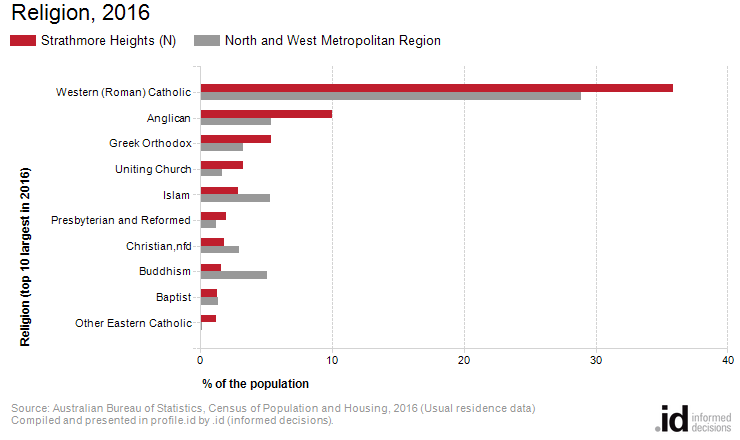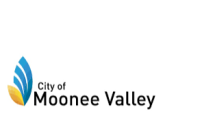Strathmore Heights (N)
Religion
In Strathmore Heights (N) in 2016, the largest religious group was Western (Roman) Catholic (35.9% of all people), while 25.1% of people had no religion and 6.9% did not answer the question on religion.
Strathmore Heights (N)'s religion statistics provide an indicator of cultural identity and ethnicity when observed in conjunction with other key variables. Religion data reveal the major concentrations of religions as well as revealing the proportion of people with no religious affiliation. There are a number of reasons for different religious compositions across areas including the country of birth and ethnic background of the population, the age of the population (belief in religion is generally stronger, the older the population) and changes in values and belief systems.
Strathmore Heights (N)'s religion statistics should be analysed in conjunction with other ethnicity statistics such as Country of Birth data and Language Spoken data to assist in identifying specific cultural and ethnic groups.
Please note: Due to changes in ABS rules around perturbation and additivity of data to protect the confidentiality of individuals, counts of individual religion groups and totals derived from them may differ slightly from those published by the ABS.
Derived from the Census question:
'What is the person's religion?'
Total population
The North and West Metropolitan Region is made up up of the following Local Government areas: Banyule (C), Brimbank (C), Darebin (C), Hobsons Bay (C), Hume (C), Maribyrnong (C), Melbourne (C), Melton (S), Moonee Valley (C), Moreland (C), Nillumbik (S), Whittlesea (C), Wyndham (C) and Yarra (C).
Source: Australian Bureau of Statistics, Census of Population and Housing (opens a new window) 2011 and 2016. Compiled and presented by .id (opens a new window)(informed decisions).
(Usual residence data)
| Religion - Ranked by size | ||||||||
|---|---|---|---|---|---|---|---|---|
| Strathmore Heights (N) - Total persons (Usual residence) | 2016 | 2011 | Change | |||||
| Religion | Number | % | North and West Metropolitan Region % | Number | % | North and West Metropolitan Region % | 2011 to 2016 | |
| Western (Roman) Catholic | 362 | 35.9 | 28.9 | 35044 | 367 | 39.4 | 34.0 | -5 |
| Anglican | 101 | 10.0 | 5.4 | 35000 | 110 | 11.8 | 7.8 | -9 |
| Greek Orthodox | 54 | 5.4 | 3.3 | 35015 | 43 | 4.6 | 3.8 | +11 |
| Uniting Church | 33 | 3.3 | 1.7 | 35043 | 48 | 5.2 | 2.5 | -15 |
| Islam | 29 | 2.9 | 5.3 | 35017 | 32 | 3.4 | 4.6 | -3 |
| Presbyterian and Reformed | 20 | 2.0 | 1.2 | 35036 | 28 | 3.0 | 1.6 | -8 |
| Christian,nfd | 18 | 1.8 | 2.9 | 35011 | 19 | 2.0 | 1.6 | -1 |
| Buddhism | 16 | 1.6 | 5.1 | 35008 | 15 | 1.6 | 5.7 | +1 |
| Baptist | 13 | 1.3 | 1.4 | 35006 | 16 | 1.7 | 1.3 | -3 |
| Other Eastern Catholic | 12 | 1.2 | 0.1 | 35028 | 9 | 1.0 | 0.1 | +3 |
The North and West Metropolitan Region is made up up of the following Local Government areas: Banyule (C), Brimbank (C), Darebin (C), Hobsons Bay (C), Hume (C), Maribyrnong (C), Melbourne (C), Melton (S), Moonee Valley (C), Moreland (C), Nillumbik (S), Whittlesea (C), Wyndham (C) and Yarra (C).
Source: Australian Bureau of Statistics, Census of Population and Housing (opens a new window) 2011 and 2016. Compiled and presented by .id (opens a new window)(informed decisions).
Excludes religions with fewer than 10 adherents.

Compiled and presented in profile.id by .id (informed decisions).

Compiled and presented in profile.id by .id (informed decisions).
Dominant groups
Analysis of the religious affiliation of the population of Strathmore Heights (N) in 2016 compared to North and West Metropolitan Region shows that there was a higher proportion of people who professed a religion as well as a higher proportion who stated they had no religion.
Overall, 67.7% of the population nominated a religion, and 25.1% said they had no religion, compared with 66.9% and 24.1% respectively for North and West Metropolitan Region.
The largest single religion in Strathmore Heights (N) was Western (Roman) Catholic, with 35.9% of the population or 362 people as adherents.
The major differences between the religious affiliation for the population of Strathmore Heights (N) and North and West Metropolitan Region were:
- A larger percentage who nominated Western (Roman) Catholic (35.9% compared to 28.9%)
- A larger percentage who nominated Anglican (10.0% compared to 5.4%)
- A smaller percentage who nominated Buddhism (1.6% compared to 5.1%)
- A smaller percentage who nominated Islam (2.9% compared to 5.3%)
Emerging groups
There were no major differences in Strathmore Heights (N) between 2011 and 2016.
